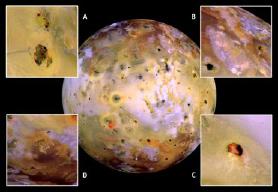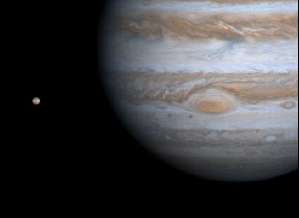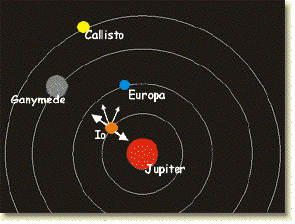Tidal Heating
 What
force is responsible for powering the volcanoes on Io? On
Earth, the heat source that produces volcanic activity comes
from energy released from the decay of radioactive materials
within the interior, as well as from heat left over from
Earth's formation. But Io is too small to have left over
accretional heat, and radioactive decay could not generate
the tremendous energy required to power all of the volcanic
activity that exists on the moon. The answer is tidal
heating. Tidal heating is the heating of the interior of one
planetary body caused by stresses induced from the
gravitational pull of another.
What
force is responsible for powering the volcanoes on Io? On
Earth, the heat source that produces volcanic activity comes
from energy released from the decay of radioactive materials
within the interior, as well as from heat left over from
Earth's formation. But Io is too small to have left over
accretional heat, and radioactive decay could not generate
the tremendous energy required to power all of the volcanic
activity that exists on the moon. The answer is tidal
heating. Tidal heating is the heating of the interior of one
planetary body caused by stresses induced from the
gravitational pull of another.
Jupiter is an enormous planet. More than 1300 Earths would fit within its volume! As a result, Jupiter exerts a tremendous gravitational force. Io, on the other hand, is a tiny moon which orbits very close to the giant planet. Io is therefore very strongly affected by the pull of Jupiter's gravity. This image taken recently by the Cassini Orbiter shows the relative size of Jupiter and Io.

If Io were Jupiter's only moon, it would not be subject to internal stresses. But there are other moons nearby which exert a gravitational pull of their own. Io's volcanic activity is caused by the powerful force of Jupiter's gravity, coupled with the gravitational pull of Io's neighboring moons--Europa, Callisto, and Ganymede. Jupiter pulls Io inward toward itself, while the gravity of the outer moons pull it in the opposite direction. These opposing forces cause the distance between Io and Jupiter to vary, making Io's orbit slightly elliptical. As a result, Io is subjected to tremendous tidal forces that alternately squeeze and stretch its interior. This causes Io's surface to rise and fall by about 100 meters (300 ft). (The highest ocean tides on Earth only reach about 18 meters (60 ft)). This perpetual friction generates enormous amounts of heat and pressure within Io, causing molten material and gases to rise through fractures in the crust and to erupt onto the surface.

Photo Credit NASA/JPL (top image) Photo Credit NASA/JPL/University of Arizona (bottom image) Illustration Credit: NASA/JPL
